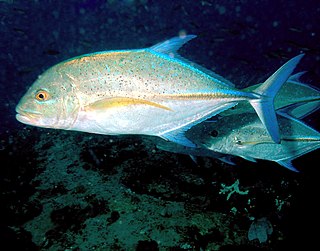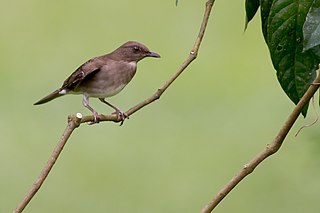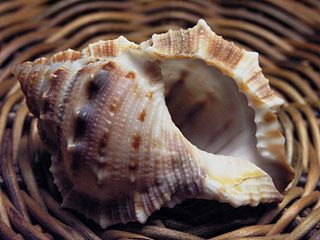
The giant trevally, also known as the lowly trevally, barrier trevally, ronin jack, giant kingfish, or ulua, is a species of large marine fish classified in the jack family, Carangidae. The giant trevally is distributed throughout the tropical waters of the Indo-Pacific region, with a range stretching from South Africa in the west to Hawaii in the east, including Japan in the north and Australia in the south. Two were documented in the eastern tropical Pacific in the 2010s, but whether the species will become established there remains to be seen.

The bluefin trevally, also known as the bluefin jack, bluefin kingfish, bluefinned crevalle, blue ulua, omilu, and spotted trevally), is a species of large, widely distributed marine fish classified in the jack family, Carangidae. The bluefin trevally is distributed throughout the tropical waters of the Indian and Pacific Oceans, ranging from Eastern Africa in the west to Central America in the east, including Japan in the north and Australia in the south. The species grows to a maximum known length of 117 centimetres (46 in) and a weight of 43.5 kilograms (96 lb), however is rare above 80 centimetres (31 in). Bluefin trevally are easily recognised by their electric blue fins, tapered snout and numerous blue and black spots on their sides. Juveniles lack these obvious colours, and must be identified by more detailed anatomical features such as fin ray and scute counts. The bluefin trevally inhabits both inshore environments such as bays, lagoons and shallow reefs, as well as deeper offshore reefs, atolls and bomboras. Juveniles prefer shallower, protected waters, even entering estuaries for short periods in some locations.

The uniform treehunter is a species of bird in the family Furnariidae. It is found in Colombia and Ecuador.

The black-billed thrush is a bird in the family Turdidae native to Colombia and also scantily distributed across Venezuela, the Guiana Shield and the western Amazon.

Pendromidae is a family of gastropods in the clade Vetigastropoda.

Bufonaria is a genus of medium-large sea snails, marine gastropod molluscs in the family Bursidae, the "frog snails".
Rugulina monterosatoi is a species of sea snail, a marine gastropod mollusc in the family Pendromidae.

Rugulina is a genus of sea snails, marine gastropod molluscs in the family Pendromidae.

Ganesa is a genus of sea snails, marine gastropod mollusks in the family Skeneidae.

Granigyra is a genus of sea snails, marine gastropod mollusks, unassigned in the superfamily Seguenzioidea.
Fossarus is a genus of sea snails, marine gastropod mollusks in the family Planaxidae.

Bursina ignobilis is a species of sea snail, a marine gastropod mollusk in the family Bursidae, the frog shells.

Bursina is a genus of sea snails, marine gastropod mollusks in the family Bursidae, the frog shells.

Tommaso di Maria Allery, marchese di Monterosato was an Italian malacologist.
Heterocrossa ignobilis is a species of moth in the family Carposinidae, endemic to New Zealand.
Rugulina antarctica is a species of sea snail, a marine gastropod mollusk in the family Pendromidae.
Rugulina tenuis is a species of sea snail, a marine gastropod mollusk in the family Pendromidae.

Rugulina verrilli is a species of sea snail, a marine gastropod mollusk in the family Pendromidae.

Nebularia is a genus of predatory sea snails, marine gastropod mollusks in the subfamily Cylindromitrinae within the family of Mitridae. This name was originally proposed as a subgenus of the genus Mitra. The type species of this genus is Mitra contractaSwainson, 1820.

Potadoma is a genus of gastropods belonging to the family Pachychilidae.












